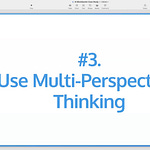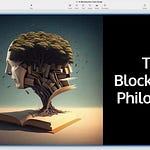Personal Note From Me
On Tuesday, we had class 5 of Augmented Awakening with Anand Rao for paid members. This class was unique because it was centered around a profoundly powerful AI prompt you can use to change your life or share with others.
Today’s follow-up post embodies what the AI Thought Leader School will be. Rather than just sharing 90-minute on-demand recordings, I removed the fluff and extracted the relevant clips to help you understand:
Why the prompt is powerful
What the prompt is
How to use it for max impact
How to follow up for amplified results
I believe in this AI-first class format because prompts help students focus on the 20% of the class that creates 80% of the value. The brutal reality is that most people never watch on-demand sessions, though I will still share the full recordings for those who do.
Once the AI Thought Leader School launches next week…
Basic paid members of Blockbuster Blueprint will receive a blockbuster prompt and follow-up posts like this one after every class.
Premium members of the AI Thought Leader School will get the follow-up posts in addition to:
120 live, prompt-centered classes throughout the year.
Full on-demand recordings and transcripts.
I will also be working with a team of 10+ people to beta test those prompts before the classes, so you get prompts that have been proven to be useful and transformative.
In this specific Augmented Awakening session (full recording coming tomorrow), Anand walks us through how to use AI to facilitate one of the most life-changing, research-backed psychology protocols ever created…
Introducing The Ideal Parent Prompt
One of the most fundamental aspects of our psyche is our attachment style—the pattern of how we form emotional bonds with others. Developed in early childhood through caregiver interactions, these patterns become internal working models that guide our connections throughout life.
There are four attachment styles:
Secure attachment: Characterized by comfort with intimacy and independence, trust in others, and the ability to regulate emotions effectively in relationships.
Anxious attachment: Marked by a strong desire for closeness and reassurance, fear of abandonment, and hypervigilance to signs of rejection or distance from others.
Avoidant attachment: Distinguished by discomfort with emotional intimacy, high valuing of self-sufficiency, and tendency to minimize or deny emotional needs in relationships.
Disorganized attachment: Characterized by inconsistent and contradictory relationship behaviors, often stemming from caregivers who were either frightening or themselves frightened, leading to both seeking and fearing closeness.
Pioneering work from the late Harvard psychiatrist Daniel P. Brown demonstrated that it's possible to change someone's attachment style in months using an "Ideal Parents" protocol.
Today’s prompt builds on this protocol.
Life-Changing Benefits of Attachment Healing
Improved relationship satisfaction and stability, as you develop the capacity for healthy intimacy, clear communication, and appropriate boundaries.
Enhanced emotional regulation, reducing anxiety, defensiveness, and reactivity while increasing your ability to stay present during difficult interactions.
Greater personal authenticity and self-worth, allowing you to show up as your true self without the protective strategies that once limited your connections with others.
The Neuroscience of Attachment Healing: Why the Ideal Parent Protocol Works
Your earliest attachment experiences aren't just emotionally significant—they literally shape your brain's architecture. When a child experiences consistent, attuned responses from caregivers, the brain develops neural pathways that support healthy emotional regulation and relationships. Conversely, when caregivers are inconsistent, unavailable, or frightening, the brain adapts by forming neural circuits that prioritize survival over connection.
For decades, scientists believed brain development was largely fixed after childhood. We now know this isn't true. Your brain remains plastic—capable of forming new neural connections—throughout your entire life. This neuroplasticity is the biological foundation that makes the Ideal Parent Protocol effective.
Three key neuroplasticity principles explain why this AI approach works:
Neurons that fire together, wire together: When you engage in the emotional experience of secure attachment through the AI conversation, you're activating neural networks related to safety, trust, and emotional regulation simultaneously. With repetition, these networks strengthen their connections.
Experience-dependent neuroplasticity: Your brain physically changes in response to experiences. The emotionally corrective experience provided by the ideal parent dialogue creates opportunities for new neural growth and reorganization.
Memory reconsolidation: When you activate an attachment-related memory or pattern, it becomes temporarily malleable. During this window, introducing new, emotionally corrective information (like the ideal parent response) can actually rewrite the neural coding of that attachment pattern.
The AI Prompt
Given what you know about me and what you think I am missing, write a letter to me from my [PARENT] pacing all my challenges and introducing that parent as if they had all the ideal parent qualities in the attached transcript that I once required.
Then, facilitate a healing conversation between me and my ideal parent. Help me respond authentically, and continue this exchange for multiple rounds, gradually moving toward resolution and secure attachment.But before you do that, redo the prompt, so it's more fitting for me given what you know about me from my history.
Instructions
Copy and paste the prompt above into ChatGPT
Add more context (optional)
Customize one variable in the prompt
Attach the transcript of the YouTube video to the prompt
Use the Havening Technique to reset your nervous system before reading the prompt
Read mindfully and take your time
Iterate with a follow-up prompt if ChatGPT’s initial response didn’t land for you
#1. Copy and paste the prompt above into ChatGPT
This is important because ChatGPT is currently the only AI model with memory of all your previous chats.
#2. Add more context (optional)
Results won't be as effective if you haven't spent time chatting with ChatGPT, as it won't have enough data to personalize its response.
You can fix this by attaching or linking to the URL of other files (journals you’ve written, content you’ve created, interviews you've done).
#3. Customize one variable in the prompt
Replace the [PARENT] variable with the parent with whom you had the most challenging relationship—where you felt least seen and supported.
#4. Attach the transcript of the YouTube video to the prompt
Anand uses the Glasp Chrome Extension to extract the transcript of the Ideal Parent protocol video in order to use it as data inside of his prompt. You can access the transcript below:
The transcript is important because it provides important context, which improves the AI’s response.
#5. Use the Havening Technique to reset your nervous system before reading the prompt
This isn't just an intellectual exercise—you're using ChatGPT to generate a new experience.
Here’s the relevant clip where Anand talks about this:
The Havening Technique
Just haven five times. Stroke slowly down the outside of your arms.
Soothe all of those aspects of you that didn't get what they needed at the time that they needed it.
Notice we're not going into content. [We’re] just soothing the nervous system.
For more on the Havening Technique and the science behind why it works, watch this short video:
#6. Read mindfully and take your time
This is the part of the class where I personally learned the most.
Rather than speed-reading for information, focus on being present for a transformative experience:
Read the AI's response slowly
Pause on parts that resonate
Allow yourself to fully experience the emotions that arise
Anand role modeled this technique by reading the AI letter from his ideal father:
Anand then went a step further and facilitated a student’s experience of reading a letter from his ideal parent to give another perspective on how to get the most from the AI’s output:
The instruction to "read mindfully and take your time" is backed by neuroscience. When you read quickly, you primarily engage the left hemisphere's language centers. When you slow down and allow yourself to feel the emotional impact of the words, you activate the right hemisphere—which processes emotional content and nonverbal meaning.
Since attachment patterns are predominantly stored in the right hemisphere, this slow, emotionally attuned reading creates the conditions necessary for neural reorganization of attachment schemas.
#7. Iterate with a follow-up prompt if ChatGPT’s initial response didn’t land for you
If ChatGPT’s letter didn’t land with you, you can follow up with this in order to continue the conversation:
Write a short response letter (even messy and half-formed) to these imagined parents.
Tell them:
What they still don’t understand.
What you actually needed.
Where they almost got it right.
Where they totally missed.
What it’s like to read their words now.
And tell them who you are now — not to seek approval, but to finally be known, on your terms.
You don’t owe them grace. You don’t owe them warmth. You don’t even owe them answers. You owe you the truth.
This follow-up idea came from one of the students in the class:
Remember: If the first attempt doesn't land, it's not a wall—it's a doorway to a more powerful follow-up conversation.
5 Prompt Variations To Deep The Impact
Neurologically, changing attachment patterns isn't a one-and-done event—it's the cumulative effect of repeated experiences that gradually strengthen secure attachment circuits while allowing insecure circuits to weaken through disuse.
If you’re especially dedicated to your healing journey, I'd recommend working through these variations in this order, with adequate time for integration between each experience.
1. Specific Attachment Needs Variation
Based on what you know about me, write a letter from my [PARENT] that specifically addresses my unmet need for[CHOOSE: safety/protection, attunement/mirroring, soothing/comfort, expressed delight, or support for exploration]. How would an ideal parent have fulfilled this specific need?Why it's powerful: This targets the exact attachment wound that may be causing the most relationship challenges, allowing for precise emotional healing.
2. Different Developmental Stages Variation
Write a letter to me from my [PARENT] as if they were ideally attuned to me during a specific critical period: [CHOOSE: infancy (0-2), early childhood (3-5), middle childhood (6-11), adolescence (12-18)]. What would they have said and done differently during this specific period?Why it's powerful: Different attachment wounds often form at specific developmental stages; this allows healing that's developmentally appropriate to when the attachment disruption occurred.
3. Reparenting in Specific Situations
Write a letter from my ideal [PARENT] about how they would have supported me through [SPECIFIC CHALLENGING SITUATION FROM MY PAST]. How would they have responded differently in a way that would have helped me feel secure, valued, and capable?Why it's powerful: This connects abstract attachment patterns to concrete lived experiences, making the healing process more tangible and directly applicable to specific memories that may still carry emotional charge.
4. Attachment-Style Specific Healing
Based on my [ANXIOUS/AVOIDANT/DISORGANIZED] attachment style that shows up as [DESCRIBE PATTERNS], write a letter from an ideal parent who specifically addresses and heals these patterns by providing exactly what I needed instead.Why it's powerful: This directly addresses the specific attachment style's core wounds with precisely targeted healing responses.
5. Future Self as the Ideal Parent
Write a letter to my younger self from my wise future self who has developed all the qualities of an ideal parent. What would my future self say to my child self about the challenges I faced and how I will eventually overcome them?Why it's powerful: This variation promotes self-compassion and integrates the healing parent archetype into one's own identity, facilitating self-reparenting skills that continue working long after the exercise.
Application Templates:
Bringing Attachment Healing Into Your Real-Life Relationships
After working with the Ideal Parent Protocol, you'll begin experiencing shifts in your internal attachment patterns. The next crucial step is applying these changes to your actual relationships. These templates that I co-created with AI guide you through that process across four key relationship domains:
Romantic relationships
Professional relationships
Parenting (Breaking Intergenerational Patterns)
Friendships











